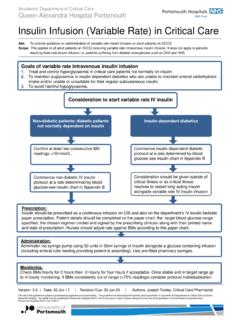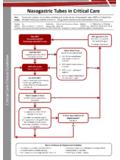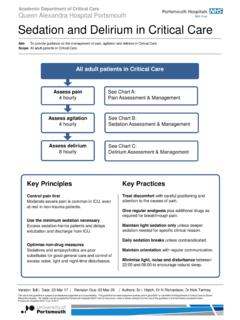Transcription of Renal Replacement Therapy in Critical Care - Portsmouth ICU
1 Renal Replacement Therapy in Critical Care Aim: To provide guidance on the choice of modality and delivery of Renal Replacement Therapy (RRT) on the ICU. Scope: All adult patients on the Intensive Care Unit who need Renal Replacement Therapy Choice of mode CVVH 35mls/kg/hour CVVHDF 35mls/kg/hour Prescription Effluent production: use mls/kg/hour effluent as above Replacement fluid: CVVH: effluent rate = Replacement fluid rate. CVVHDF: effluent rate = 50% dialysate / 50% Replacement . Pre/post dilution ratio: initially use 30% pre- / 70% post-dilution. Blood flow rates: set according to Table A below Anticoagulation: according to guideline below Patient fluid removal rate: titrate to volume status Check biochemistry after 6-8 hours on Therapy ; thereafter check daily (including phosphate) or as clinical need dictates.
2 If starting Urea >30 mmoll-1, do not let Urea fall by more than 1/3 during first 24 hours (NB still beware if Urea 25-30 mmoll-1) Consider break/termination of Therapy if patient has good solute clearance, normal pH, normal potassium and is euvolaemic/persistently passing good urine volumes. Filters should be electively taken down where possible rather allowed to clot (to minimise blood loss) All filters should be electively taken down after 72 hours and a fresh circuit built. If Therapy is terminated for 3 hours or more and the vascath remains in situ it should be locked with Taurolock. The vascath should be removed as soon as it is no longer needed for ongoing Therapy . First choice for most ICU admissions with multi organ failure Septic shock/severe sepsis CVVH 25mls/kg/hour SCUF Recovering multi organ failure but ongoing need for RRT AKI with high urea (initial setting) Failure of CVVH Limited period of time for Therapy Fluid removal only Re-Assess Daily Need for RRT/mode of RRT Fluid balance Electrolytes including phosphate & magnesium (usually need daily Replacement ) Drug dose adjustment based on Renal handbook & pharmacist DVT prophylaxis Vascath for signs of infection Remember RRT may mask a fever Critical Care Clinical Guideline Version: 2 Date: 06 Sep 13 An equality impact assessment has been applied to this policy (Appendix D).
3 This guideline is subject to professional judgment and accountability. Ratified by: Critical Care Governance Group Revision due: 06 Sep 15 Author: Dr S Blakeley Produced by: Critical Care Governance Group Delivery of Therapy Termination of Therapy Critical Care Clinical Guideline No Anticoagulation 20 ml saline in 20 ml syringe Heparin Anticoagulation 20mls heparin sodium 1000 IU/ml in 20ml syringe High risk of bleeding * INR APTR Platelets 60 < 24 hours post surgery Intracerebral / GI bleed therapeutic anticoagulation Moderate risk of bleeding * INR APTR Platelets 60-99 < 48 hours post surgery Low risk of bleeding Normal clotting INR APTR Platelets 100 * If individual patient felt to be at risk of bleeding for other reasons use low dose or no heparin # Prime with saline ONLY if suspicion/diagnosis of heparin induced thrombocytopenia (HIT)
4 $ Bleeding should be assessed to determine clinical significance If recurrent filter clotting do not increase heparin Refer to guidance below APTR Bleeding$ Action Monitoring Standard Heparin Low Dose Heparin or less None Continue 10 IU/kg/hr Continue 5 IU/kg/hr Check APTR 12 hourly unless otherwise indicated or more None Reduce to 5 IU/kg/hr Stop heparin Recheck APTR 4 hrs after heparin dose change ANY Yes Reduce to 5 IU/kg/hr or run heparin free depending on significance of bleeding Stop heparin Check APTR immediately on identifying new bleeding Recheck APTR 4 hrs after reducing or stopping heparin Anticoagulation for Renal Replacement Therapy Prime circuit with heparinised saline (1000mls sodium chloride with 5000 units heparin sodium) # Standard Heparin 10 IU/kg/hr Check APTR 4 hours after starting heparin Low Dose Heparin 5 IU/kg/hr Check APTR 4 hours after starting heparin No Heparin Critical Care Clinical Guideline Stop Heparin Anticoagulation if: APTR is despite low dose heparin (can be continued at the discretion of the consultant in exceptional circumstances) Significant bleeding is seen Patient is due for theatre/invasive procedure INR rises to or platelets fall < 60 Concern regarding heparin induced thrombocytopenia (note: circuit will need to be rebuilt with NO heparin in the priming solution) If the Filter Clots Repeatedly: Ensure good vascular access: blood should flow freely from both lumens of the Vascath.
5 If not, reposition or re-site line. Ensure patient has adequate intravascular volume. Ensure appropriate blood speeds are achieved right from the start of Therapy . Change pre/post dilution split to 50:50 to increase haemodilution within the filter. A 70:30 pre/post dilution split can be used at the discretion of the consultant, remembering there will be a significant reduction in solute clearance unless there is a compensatory increase in effluent production. Filters do not clot due to lack of heparin. In septic patients there is often fouling of the filter membrane due to inflammatory proteins leading to a shortened filter survival time. Table A: exchange volume, pre/post dilution split and minimum blood pump speed for RRT Note: If the minimum blood flow cannot be achieved, reasons should be sought such as access problems or severe haemodynamic instability.
6 Remember good blood flow leads to better filter function and solute clearance. Renal Replacement Therapy in Critical Care (2013) dated 06 Sep 13 4 TABLE OF CONTENTS 1. Introduction 2. Purpose 3. Scope 4. Definitions 5. Duties and Responsibilities 6. Process 7. Training Requirements 8. Monitoring Compliance with, and the Effectiveness of Procedural Documents 9. References and Associated Documents Appendix A. Checklist for the Review and Ratification of Procedural Documents and Consultation and Proposed Implementation Plan Appendix B. Equality Impact Assessment Renal Replacement Therapy in Critical Care (2013) dated 06 Sep 13 5 1. INTRODUCTION 8% of admissions to the Department of Critical Care require Renal Replacement Therapy (RRT). Our haemofiltration machines offer the full range of continuous Renal Replacement therapies: continuous veno-venous haemofiltration (CVVH), continuous veno-venous haemodialysis (CVVHD), continuous veno-venous haemodiafiltration (CVVHDF) as well as slow continuous ultrafiltration (SCUF).
7 therapeutic plasma exchange (TPE) is performed using the same machine but will not be discussed in this guideline. Evidence shows that the method of Renal Replacement Therapy should be tailored to the individual, and in particular it should be dosed according to the patient s body weight and to the clinical situation. Studies have shown there is no difference in outcome between 20-25mls/kg/hour compared with 35mls/kg/hour of effluent production. This guideline however recommends that the higher dose of 35mls/kg/hour is still used in certain clinical situations, most notably in septic patients who have multi organ failure when they first present. This is to compensate for periods of intentional or unintentional down time that may lead to delivered dose falling short of prescribed dose.
8 When the patient is acutely unwell it is very important to ensure that the patient receives effective Therapy . Key points in selecting the mode of RRT include: a. Blood flow rates should be optimised to reduce filter clotting and improve efficiency. b. The rate of effluent production should be dosed according to patient body weight at either 25mls/kg/hour or 35mls/kg/hour of effluent production depending on the clinical scenario. The patient weight is taken to be the working weight of the patient, the weight used for drug/infusion calculations. c. Replacement fluid should be infused as a pre and post dilution split to maximise both filter life (pre dilution) and solute clearance (post dilution). d. Septic patients should have a predominantly convective mode of Therapy (CVVH).
9 Recent studies have not shown any survival benefit with high volume haemofiltration (effluent flow rates in excess of 35mls/kg/hour) in the management of severe septic shock. The use of flow rates above 35mls/kg/hour in these patients is at the discretion of the duty ICU consultant. e. Patients with high solutes should not have a rapid reduction in their solute levels in the first 24-48 hours. f. If fluid removal only is the goal of Therapy use slow continuous ultrafiltration (SCUF). g. In patients with profound hyper/hyponatraemia then the delivery of Therapy should be modified to minimize rapid correction of sodium. Further guidance in this situation can be found on the departmental intranet. The very nature of continuous Renal Replacement Therapy (CRRT) means that blood is continually in contact with the tubing of the circuit and the membrane of the filter.
10 This can lead to activation of the coagulation cascade resulting in low levels of clotting within the filter reducing efficiency and ultimately leading to complete clotting and loss of the circuit. Recurrent clotting of the circuit leads to inadequate treatment and loss of circuit blood. Continual rebuilding of the circuit is a drain on resources, both nursing staff and financial. Some form of anticoagulation is generally used to maintain filter patency. The commonest form of anticoagulation on Intensive Care Units is unfractionated heparin, but other alternatives include regional citrate anticoagulation, low molecular weight heparin and prostacyclin. Renal Replacement Therapy in Critical Care (2013) dated 06 Sep 13 6 Balanced against this is the risk to the patient of bleeding and adverse effects of the anticoagulation itself.



